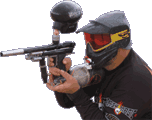  |
|
|
|
|
|
|
  |
|
|
|
|
|
|

What
do you think?
|

Palmer's Squall By Bill Mills - July 2004 Photos by Dawn Mills In the 1980s, Glenn Palmer took his background as a gunsmith and combined it with his love of paintball to establish Palmer’s Pursuit Shop in Sacramento, CA. Palmer felt that a shoulder injury restricted how fast he could pump his customized paintguns, so he developed a pneumatic automation system to recock his paintgun each time the trigger was pulled. In a world of pump action paintguns, a reliable, gravity fed semi-auto was a hot commodity. Since its early days Palmer’s Pursuit Shop has expanded and become a father and son business with Glenn’s son Craig joining him. While the company is well known for their mass produced products like the Rock low pressure regulator, and the Stabilizer inline regulator, they still do what they did from the beginning – true airsmithing and the construction of custom built paintguns.
An analogy to paintguns could be drawn
in the motorcycle world. Some riders will ride a “custom” bike that
is mass manufactured, while others will turn to a shop that builds truly
custom choppers from the ground up based on what the customer orders, down
to the size and shape of the frame.
The construction process for this Squall started by placing the order. This took the form of a number of e-mails exchanged with Craig Palmer describing the desired length, features and finish. Pricing is also arrived upon in this manner. It starts with the base price for the general configuration and is adjusted with the specifics of the order, depending on changes in the expected labor and materials needed to do the build. There are two main differences between the Squall variant and a typical Typhoon. First and most visible is that it has a limited capacity spring driven feed system for the paintballs, and second is that instead of refillable CO2 tanks or HPA systems, it is built to use disposable 12-gram CO2 cartridges as a power source. This makes a holsterable semi-auto pistol with a spring fed magazine on top of the barrel. While this is admittedly not the most practical of paintguns due to the limited paint and air supply, being custom built it is as much a show-piece as a paintgun – much like custom minitrucks on which hydraulic systems to lift and tilt the bed and cab are more about a nice truck than serving work as a dump truck. Functionally the Squall is well suited for use by a scenario or big game general who won’t be up on the front line, but needs to carry a paintgun to ward off those pesky assassination attempts, and wants it to look very good.
The barrel was built just over 12 inches in length with a feed port in the rear bringing it in at 8.5 inches from muzzle to breech. As with most of Palmer’s Custom built paintguns, the barrel is an integral part of the receiver, and cannot be swapped out (though some Typhoons were produced in the 1990s for Bad Boyz Toyz which accepted threaded barrels.)
This is customized from the standard design which is a simple knob, another option with the custom build. A slight twist is all that is needed to unlock the cap, and then it can be slid out the back of the magazine. On the front of the magazine cap is a curved piece of Delrin, which directs paintballs from the back of the magazine downward to the breech. Atop the magazine is a 3/8-inch sight rail, grooved down the center so that it can be used by itself as a sight, or as a mount for a red-dot or similar sight.
Below the barrel is the lower receiver, which houses the exhaust valve and hammer systems. In the rear is the spring driven hammer. When released by pulling the trigger, the hammer slides forward striking the valve. Velocity is adjusted by a hex screw on the rear which changes the pressure on the hammer’s spring. Turning it in increases velocity, while turning it out lowers velocity. The valve itself is of Palmer’s design. Unlike Sheridan/PMI valves it does not have a CO2 piercing pin attached to the valve core. Instead Palmer uses a hollow pin in a cup seal to pierce and seal the 12 gram cartridge.
Straddling the barrel on either side
are the low-pressure regulator and the recocking ram which are the heart
and muscles of the pneumatic recocking system. On the right side
of the body is the LPR. It draws gas from the main exhaust valve’s
source, limits its pressure and then routes it to a four-way valve in the
grip frame. The firing cycle for the Typhoons begins with the trigger being pulled which releases the hammer, striking the valve and sending a puff of gas up to the bolt, propelling a paintball out of the barrel. As the trigger is pulled further back, and small link arm pivoting in the trigger shoe activates the four way valve inside the grip frame. This directs low-pressure gas to the cocking ram pulling back the bolt, which in turn pulls back and cocks the hammer. The trigger must be held back long enough for a paintball to drop into the breech, and when it is released, the four-way valve then directs gas to the ram, which closes the bolt chambering the paintball.
On the field at Hurricane Paintball in Palm Bay, Florida, using the Squall was reminiscent of paintball in the 1980s, stalking through the woods with only a pistol in hand. It proved to be different in two distinct ways. First in that everyone else on the field could spit out a couple hundred paintballs without reloading, and second in that this pistol, unlike those bolt action and pump models from the 80s, could follow up a first shot with a few more as a semi-auto. Working under cover fire of other players, and creeping through the brush where possible, the Squall was definitely usable even without raining paint. Longballing with accuracy by volume fire was out of the question, so use of the Squall meant flanking opponents and setting up angles of fire that they weren’t expecting. It proved effective with the first player who was eliminated with a shot around the side of a bunker while he was looking the other direction.
The use of CO2 as a power source, particularly a 12-gram cartridge meant that the Squall could shoot more shots per cartridge when fired a shot at a time, rather than rapid firing through the 10 shots in the magazine. By firing more slowly, the cartridge was allowed time to absorb heat from the air, and regain pressure after each shot. In typical use on the field, it was no problem to fire 20 shots on a cartridge while retaining usable velocity, even more if shooting at closer targets where not as much velocity is needed. This is quite a feat of efficiency, considering that the Squall is using gas for the re-cocking system as well as to fire the paintball. Many early pump action paintguns could only fire twenty or so shots on a single 12-gram cartridge.
Because the Squall lacks mounting holes for a bottom-line, it was not locked onto a test stand for performance testing. However, it was checked by manually firing over a recording chronograph, fired once at a rate of approximately 1 ball per second, and once rapid firing as quickly as possible, in both cases with pauses to reload. The chronograph confirmed that the Squall used CO2 from the 12-gram cartridge more efficiently when the cartridge was given time to recover and absorb heat between shots. Even when rapid fired, the velocity was stable for three shots, then began dropping off. After a pause to reload it was again stable for three shots before dropping off.
The conclusion drawn from the testing was that even shooting in three round bursts, waiting a second or two, then firing the next burst would give the maximum rate of fire while maintaining velocity for tight shot groupings. Some Squall users report as many as twenty-five or more usable shots are attainable by waiting even longer between the shots, though in practice on the field, 20 seemed like a good point to swap the cartridge to avoid any noticeable velocity drop. This drop off rate of course is an issue facing the 12-gram powered Squall and is not related to other Typhoon configurations which are set up to use refillable CO2 tanks or compressed air.
|
| Copyright © 1992-2019
Corinthian Media Services. WARPIG's webmasters can be reached through our feedback form. All articles and images are copyrighted and may not be redistributed without the written permission of their original creators and Corinthian Media Services. The WARPIG paintball page is a collection of information and pointers to sources from around the internet and other locations. As such, Corinthian Media Services makes no claims to the trustworthiness or reliability of said information. The information contained in, and referenced by WARPIG, should not be used as a substitute for safety information from trained professionals in the paintball industry. |